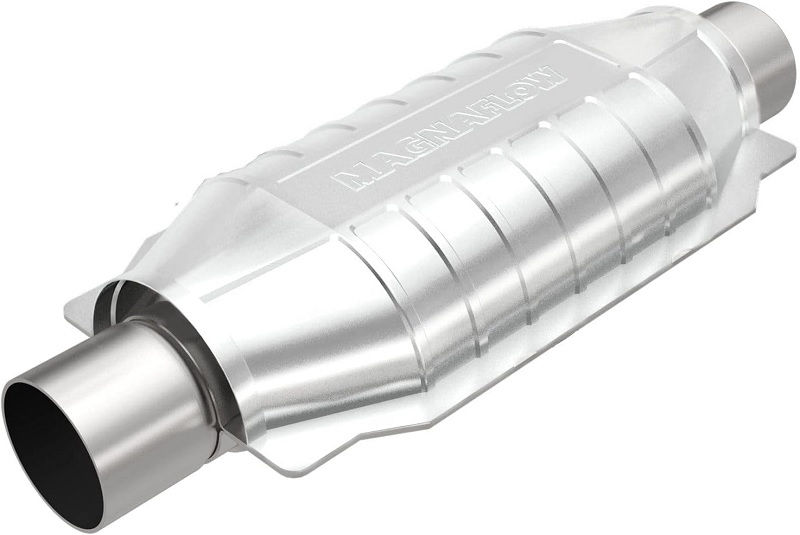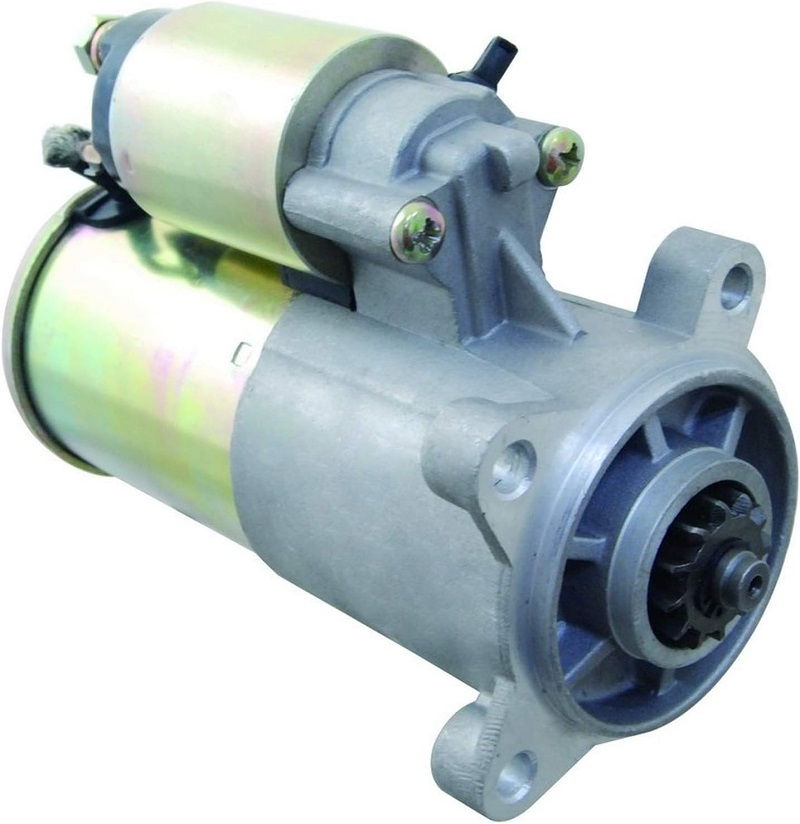This post contains affiliate links. This means I will make a commission at no extra cost to you should you click through and make a purchase [ “As an Amazon Associate, I earn from qualifying purchases.” ]. Read the full disclosure here.
2003 Ford Expedition Catalytic Converter GuideMechanic.Com When it comes to maintaining the performance and efficiency of your 2003 Ford Expedition, one crucial component that should not be overlooked is the catalytic converter.
This vital exhaust system part plays a significant role in reducing harmful emissions and ensuring compliance with environmental regulations.
See Also: Ford Ranger Catalytic Converter
In this comprehensive guide, we will delve into the importance of the 2003 Ford Expedition catalytic converter, its function, signs of potential issues, and essential maintenance tips to keep your vehicle running smoothly and effortlessly.
Understanding the Function of the Catalytic Converter
Check out this MagnaFlow 99006HM HM Grade Universal Catalytic Converter, 2.5″ Inlet/Outlet (EPA Compliant)

The catalytic converter is an essential component of your 2003 Ford Expedition’s exhaust system. Its primary function is to reduce harmful emissions produced during the combustion process, transforming them into less harmful substances before they are released into the environment. The converter achieves this through a series of chemical reactions that take place within its core.
Conversion of Harmful Gases
The catalytic converter contains a honeycomb-like structure made of ceramic or metal, coated with precious metals such as platinum, palladium, and rhodium.
As the exhaust gases flow through this honeycomb structure, the harmful gases, such as carbon monoxide (CO), nitrogen oxides (NOx), and unburned hydrocarbons (HC), come into contact with the catalysts. The catalysts facilitate chemical reactions that convert these harmful gases into less harmful substances.
Oxidation Reaction
One of the primary chemical reactions that occur within the catalytic converter is the oxidation reaction. During this process, the catalysts facilitate the conversion of carbon monoxide (CO) and unburned hydrocarbons (HC) into carbon dioxide (CO2) and water (H2O). This reaction helps to reduce the emission of harmful gases into the atmosphere.
Reduction Reaction
Another crucial chemical reaction that takes place within the catalytic converter is the reduction reaction. This reaction involves the conversion of nitrogen oxides (NOx) into nitrogen (N2) and oxygen (O2).
See Also: 2013 Ford Explorer Catalytic Converter
By reducing the levels of nitrogen oxides, the catalytic converter plays a vital role in minimizing air pollution and its detrimental effects on the environment.
Signs of Potential Catalytic Converter Issues

While the catalytic converter is designed to be durable and long-lasting, it can develop issues over time. Recognizing the signs of potential problems with your 2003 Ford Expedition catalytic converter is essential for timely diagnosis and resolution. Here are some common indicators of catalytic converter issues:
- Check engine light: If your vehicle’s onboard diagnostic system detects a problem with the catalytic converter, it will trigger the check engine light on your dashboard.
- Poor engine performance: A failing catalytic converter can cause reduced engine power, sluggish acceleration, and a noticeable decrease in overall performance.
- Increase in fuel consumption: A malfunctioning catalytic converter can lead to increased fuel consumption, as the engine struggles to operate efficiently.
- Foul odor: A strong rotten egg smell emanating from the exhaust can be a sign of a failing catalytic converter.
- Loud exhaust noise: A damaged or clogged catalytic converter may produce unusual noises, such as rattling or hissing sounds.
Diagnosis and Troubleshooting Techniques
Diagnosing catalytic converter issues requires a systematic approach and the use of appropriate diagnostic techniques.
Here are some troubleshooting methods that can help identify problems with your 2003 Ford Expedition catalytic converter:
- Scan for error codes: Using a diagnostic scanner, retrieve error codes from your vehicle’s onboard computer system. These codes can provide valuable information about the specific issue affecting the catalytic converter.
- Exhaust backpressure test: This test measures the pressure within the exhaust system to determine if there is a blockage or restriction that may be affecting the catalytic converter’s performance.
- Visual inspection: Physically inspect the catalytic converter for any signs of damage, such as cracks, dents, or leaks. Additionally, check for the presence of contaminants, such as coolant or oil, which may indicate internal damage.
- Emission testing: Conducting an emission test can help determine if the levels of harmful gases emitted from your vehicle exceed acceptable limits, indicating a potential issue with the catalytic converter.
Replacing the Catalytic Converter
If diagnostic tests confirm that your 2003 Ford Expedition catalytic converter is faulty and needs replacement, it is crucial to choose a suitable replacement and follow the proper installation procedure.
Selecting a Replacement Catalytic Converter
When selecting a replacement catalytic converter, it is essential to choose one that is specifically designed for your 2003 Ford Expedition.
See Also: Ford F150 Throttle Body
Consider factors such as compatibility, emissions standards compliance, and the reputation of the manufacturer. Opting for a high-quality catalytic converter ensures optimal performance and longevity.
Installation Process
Replacing the catalytic converter requires careful attention to detail and adherence to specific steps. Here is a general outline of the installation process:
- Ensure the vehicle is parked on a level surface and the engine is cool.
- Disconnect the negative battery cable to prevent electrical hazards.
- Raise the vehicle using a jack and securely support it on jack stands.
- Locate the catalytic converter, which is typically positioned between the exhaust manifold and the muffler.
- Depending on the design of your vehicle, you may need to remove other components, such as heat shields or oxygen sensors, to access the catalytic converter.
- Unbolt the old catalytic converter from the exhaust system, taking care not to damage any surrounding components.
- Install the new catalytic converter by securely bolting it in place, ensuring proper alignment.
- Reinstall any components that were removed during the process, such as heat shields or oxygen sensors.
- Lower the vehicle and reconnect the negative battery cable.
- Start the engine and check for any exhaust leaks or abnormal noises.
Maintaining and Extending the Lifespan of Your Catalytic Converter

Regular maintenance and proper care can significantly extend the lifespan and performance of your 2003 Ford Expedition catalytic converter. Here are some essential maintenance tips:
- Follow the manufacturer’s recommended maintenance schedule for your vehicle, including regular engine tune-ups and oil changes. A well-maintained engine is less likely to produce excessive emissions that can harm the catalytic converter.
- Ensure your vehicle’s fuel and ignition systems are functioning correctly. Faulty spark plugs, oxygen sensors, or fuel injectors can negatively impact the catalytic converter’s efficiency.
- Avoid using leaded gasoline or any fuel with a higher octane rating than what is recommended for your vehicle. Using the wrong fuel can damage the catalytic converter.
- Inspect the exhaust system regularly for any signs of leaks, damage, or loose connections. Addressing these issues promptly can prevent further damage to the catalytic converter.
- Be mindful of your driving habits. Aggressive driving, frequent short trips, and excessive idling can increase the strain on the catalytic converter and decrease its lifespan.
- Regularly check your vehicle’s “check engine” light and address any issues promptly to prevent potential damage to the catalytic converter.
Environmental Impact and Compliance
The catalytic converter plays a crucial role in reducing air pollution and ensuring compliance with environmental regulations.
By converting harmful emissions into less harmful substances, it helps minimize the negative impact of vehicle exhaust on the environment and human health.
Reducing Harmful Emissions
The primary goal of the catalytic converter is to reduce harmful emissions, such as carbon monoxide, nitrogen oxides, and unburned hydrocarbons, which contribute to air pollution and various environmental issues.
By facilitating chemical reactions that convert these harmful gases into less harmful substances, the catalytic converter helps mitigate their adverse effects.
Meeting Regulatory Standards
The installation and proper functioning of a catalytic converter are required by law in many countries to ensure compliance with emissions standards.
See Also: Ford Explorer Catalytic Converter
Governments worldwide have implemented stringent regulations to limit the amount of harmful pollutants released into the atmosphere, and catalytic converters play a vital role in meeting these standards.
Frequently Asked Questions about Catalytic Converters
Here are answers to some common queries and concerns related to catalytic converters:
Q: How often should I replace my catalytic converter?
A: The lifespan of a catalytic converter can vary depending on various factors, such as driving conditions, maintenance, and quality. Generally, a well-maintained catalytic converter can last for around 100,000 to 150,000 miles. However, certain issues, such as contamination or damage, may require earlier replacement.
Q: Can I drive my vehicle with a faulty catalytic converter?
A: It is not advisable to drive a vehicle with a faulty catalytic converter for an extended period. A malfunctioning converter cancause decreased engine performance, increased fuel consumption, and potential damage to other components of the exhaust system.
Additionally, driving with a faulty catalytic converter may result in a failed emissions test, making your vehicle non-compliant with regulations.
Q: Can I clean a clogged catalytic converter?
A: Cleaning a clogged catalytic converter is not recommended. Once a catalytic converter becomes clogged, it is often irreversible and requires replacement. Attempting to clean it may cause further damage or compromise its effectiveness in reducing emissions.
Q: Are there any aftermarket catalytic converters available?
A: Yes, there are aftermarket catalytic converters available in the market. However, it is essential to ensure that the aftermarket catalytic converter meets the necessary emissions standards and is compatible with your 2003 Ford Expedition.
It is advisable to consult with a reputable automotive professional or refer to manufacturer guidelines before purchasing an aftermarket catalytic converter.
Exploring Alternatives to Traditional Catalytic Converters
While traditional catalytic converters have been effective in reducing harmful emissions, researchers and manufacturers are continuously exploring alternative solutions to enhance their efficiency and reduce environmental impact. Here are a few emerging technologies and innovations:
1. Advanced Catalysts
Scientists are working on developing catalysts with improved efficiency and durability. These advanced catalysts may utilize different materials or combinations of catalysts to optimize the conversion of harmful gases into less harmful substances.
The goal is to enhance catalytic converter performance while reducing the reliance on precious metals, making them more cost-effective and sustainable.
2. Electric Catalytic Converters
Electric catalytic converters are a promising alternative that utilizes electric fields to enhance the catalytic reactions.
By applying an electric field to the catalyst, the conversion of harmful gases can be accelerated, leading to improved efficiency and reduced emissions.
Electric catalytic converters have the potential to revolutionize the automotive industry by offering higher performance and lower energy consumption.
3. Catalytic Converter Coatings
Coating the catalytic converter with specialized materials can enhance its efficiency and reduce the need for large, bulky converters.
These coatings can provide better temperature control and increase the active surface area of the catalyst, allowing for more effective conversion of harmful gases.
Additionally, innovative coatings may help reduce the amount of precious metals required, making catalytic converters more sustainable and cost-efficient.
4. Diesel Particulate Filters
For diesel-powered vehicles, diesel particulate filters (DPFs) are crucial in reducing particulate matter emissions. These filters capture and trap soot and other fine particles, preventing them from being released into the atmosphere.
By combining catalytic converters with DPFs, diesel vehicles can achieve significant reductions in both particulate matter and harmful gas emissions.
The Future of Catalytic Converters
The future of catalytic converters holds great promise in terms of enhanced performance, reduced environmental impact, and increased sustainability.
As the automotive industry continues to evolve and innovate, catalytic converters will play a vital role in achieving cleaner and more efficient vehicles. Some potential advancements and developments include:
1. Smart Catalytic Converters
Smart catalytic converters equipped with sensors and advanced control systems can monitor and adjust their performance in real-time.
See Also: Ford Fusion Purge Valve
These intelligent converters can optimize their operation based on factors such as engine load, temperature, and emissions levels, ensuring peak efficiency and reducing pollutant emissions even further.
2. Integration with Hybrid and Electric Vehicles
As hybrid and electric vehicles become more prevalent, catalytic converters may evolve to accommodate these alternative powertrains.
While electric vehicles produce zero tailpipe emissions, integrating catalytic converters into hybrid vehicles can help reduce emissions during the combustion phase or when the internal combustion engine is in use.
3. Enhanced Durability and Longevity
Advancements in materials and manufacturing techniques can lead to catalytic converters with increased durability and longevity.
By developing components that can withstand higher temperatures, resist contamination, and resist wear and tear, catalytic converters can operate optimally for longer periods, reducing the need for frequent replacements.
4. Sustainable Manufacturing
Manufacturers are actively exploring ways to make catalytic converter production more sustainable. This includes reducing the reliance on precious metals, utilizing recycled materials, and implementing eco-friendly manufacturing processes.
Sustainable manufacturing practices can help minimize the environmental impact of catalytic converters and contribute to a more sustainable automotive industry overall.
In conclusion, the 2003 Ford Expedition catalytic converter is a crucial component that plays a significant role in reducing harmful emissions, ensuring regulatory compliance, and maintaining optimal vehicle performance.
By understanding its function, recognizing signs of potential issues, and following proper maintenance practices, you can prolong the lifespan of your catalytic converter and contribute to a cleaner and healthier environment.
As technology continues to advance, the future holds promising developments to further enhance catalytic converter efficiency and sustainability, supporting the ongoing efforts towards a greener automotive industry.
- P0000 Through P0099: Understanding OBD-II Trouble Codes - February 11, 2025
- P0000 Through P0199: Understanding OBD-II Trouble Codes - February 10, 2025
- P0080 Exhaust Valve Control Solenoid Circuit High (Bank 1) - February 9, 2025
